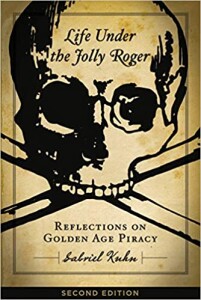 Life Under the Jolly Roger: Reflections on Golden Age Piracy is Gabriel Kuhn’s detailed look at that era of piracy, and a celebrated enough volume that a second edition was recently released, and adds some interesting information to the whole. From his early introductory elements, Kuhn makes it clear that he is somewhat of a radical himself yet is attempting to find a honest middle ground between typical conservative and radicalist ways of looking at historical pirates of the golden age.
Life Under the Jolly Roger: Reflections on Golden Age Piracy is Gabriel Kuhn’s detailed look at that era of piracy, and a celebrated enough volume that a second edition was recently released, and adds some interesting information to the whole. From his early introductory elements, Kuhn makes it clear that he is somewhat of a radical himself yet is attempting to find a honest middle ground between typical conservative and radicalist ways of looking at historical pirates of the golden age.
Like many good academic volumes, Life Under The Jolly Roger starts largely by defining its subject matter, and discusses those sources that contribute to this book. One admirable factor in this book is Kuhn’s willingness to admit that he is working off of incomplete information. First hand accounts of piracy in this time are rare enough to border on non-existent, with many of the easiest sources to find being court records and historical volumes with known liberties concerning the actual facts contained within. When such a problem comes into play, many authors would paper oVer it. Kuhn instead chooses to simply state what is unsure, and what material he is using where a conjecture is made.
The examinations of pirates in relation to various anti-authoritarian models is especially interesting, and allows a reader to understand better the situational nature of pirates and the ways in which revolutionary activity was often incidental to their actions overall (to say nothing of their reasons for them). Further, examinations of race relations and sexuality related to pirates presents a less idealized but still fascinating look at the unusually forward appearance many of these had.
After the text proper comes a number of new additions largely made up of interviews Kuhn gave relating to piracy. They are individually interesting enough, however many of them contain large amounts of redundant information to one another, as well as the larger body of text. There is at a singular exception to this
One interesting new piece included is an email exchange between the author and Anna Vo, dealing with the specific cultural subset do pirates as well as anylizing the use of pirates as a symbol in relation to the point of view of an individual who sees them as (particularly in a modern context) little more than violent brutalist for-profit criminals. The use of a variety of modern day analogies, and dissecting the ways in which those aren’t qUte parallel, serve well to illustrate the difficulties in understanding such groups.
After these come a number of indices, appendixes, and lists of notes and sources which would all prove invaluable to a researcher seeking out more information on the topic. Indeed, if one wishes to reference to those sections alone they will find a treasure-trove to support almost any argument they might make.
Overall Life Under the Jolly Roger is an excellent look at the golden age of piracy from a somewhat political point of view. The book cites sources well, makes arguments cleanly and succinctly, and has the integrity to admit when an answer is not clear. While written from a radical point of view, Gabriel Kuhn’s book is easy to recommend to almost anyone looking at pirates from an academic point of view.
(PM Press 2020)
